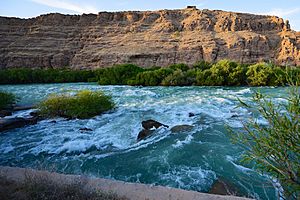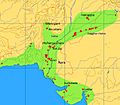Sarasvati River facts for kids

The Sarasvati River is a famous river from ancient Indian texts called the Rigveda. It was very important in the Vedic religion. The river is mentioned in almost all parts of the Rigveda.
The goddess Sarasvati was first seen as the river itself. Later, she became a separate goddess. Many Hindus also believe the Sarasvati River exists in a spiritual form. They say it joins the sacred rivers Ganges and Yamuna at a special meeting point called the Triveni Sangam.
Contents
Where Was the Sarasvati River?
Ancient texts like the Rigveda describe the Sarasvati River. The Nadistuti hymn in the Rigveda says the Sarasvati was located between the Yamuna river in the east and the Sutlej river in the west. Later texts, like the Mahabharata, mention that the Sarasvati River dried up in a desert.
The Ghaggar-Hakra River Idea
Since the late 1800s, many experts have thought the Vedic Sarasvati River is the same as the Ghaggar-Hakra River system. This river system flows through parts of northwestern India and eastern Pakistan. It is located between the Yamuna and the Sutlej rivers.
Satellite pictures show that a much larger river once flowed where the Ghaggar River is today. Many important sites of the Indus Valley Civilization are found along this ancient riverbed. These sites include Kalibangan in Rajasthan, Banawali and Rakhigarhi in Haryana, and Dholavira and Lothal in Gujarat.
Challenges with the Ghaggar-Hakra Idea
However, some experts find it difficult to say the Sarasvati is definitely the Ghaggar-Hakra. The Rigveda mentions the Ghaggar-Hakra separately from the Sarasvati. Also, the Ghaggar-Hakra is described as having dried up by the time the Vedic texts were written.
One expert, Annette Wilke, said the Ghaggar-Hakra had become a "small, sorry trickle in the desert." This happened around the time the Vedic people moved into northwest India. Recent studies suggest the Ghaggar-Hakra system was fed by monsoon rains. The Indus Valley Civilization might have declined because of climate change. The monsoons that fed these rivers became weaker about 4,000 years ago.
The Helmand River Idea
Another idea is that the "Sarasvati" could be the Helmand River. This river is also known as Haraxvati and is located in southern Afghanistan. The name "Sarasvati" might have been used again for the Ghaggar-Hakra river after the Vedic tribes moved to the Punjab region.
Some even suggest that the Rigveda's "Sarasvati" might refer to two different rivers. The older parts of the Rigveda might be talking about the Helmand River. The newer parts, like the 10th mandala, might be talking about the Ghaggar-Hakra.
Modern Importance of the Ghaggar-Hakra Idea
In the early 2000s, the idea of the Sarasvati being the Ghaggar-Hakra became very important. Some people suggested that the Rigveda was written much earlier than thought. They also started calling the Indus Valley Civilization the "Sarasvati culture" or "Indus-Sarasvati Civilization." This suggests that the Indus Valley and Vedic cultures were the same. This idea also goes against the Indo-Aryan migrations theory. That theory suggests a migration happened around 1500 BCE.
Images for kids
-
Painting of Goddess Saraswati by Raja Ravi Varma
-
Outline of the Indus Civilization, with many settlements along the Ghaggar-Hakra, which had dried-up by the time of the Indo-Aryan migrations.
-
Helmund river basin with its tributary, the Arghandab River. These rivers start in the Hindu Kush mountains in northern Afghanistan. They flow into Hamun Lake in southern Afghanistan, near the border of Iran. The Helmund basin was known in ancient Iranian Avestan as Haraxvatī and Harahvaiti. This name is related to the mythological Iranian Avestan Arədvī Sūrā Anāhitā river and the Sarasvati river.
See also
 In Spanish: Río Sarasvati para niños
In Spanish: Río Sarasvati para niños







